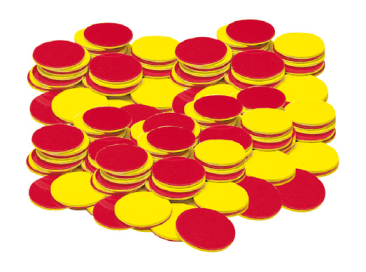Diagnostic questions
- a. What number comes after 4?
b. What number comes before 8? - a. What are two numbers that can be added to make 5?
b. Ask the student to find other pairs of numbers that can be added to make 5. - a. What number comes after 9?
b. What number comes before 13?
c. What number comes after 24? - a. What are two numbers that can be added to make 10?
b. Ask the student to find other pairs of numbers that can be added to make 10.
What to notice in the student’s response
Does the student know forward and backward number sequences?
Can the student recall basic facts for making 5? If necessary, provide blue and yellow counters and ask the student to use counters of both colours to make a set of five. Use their response to write an equation. For example, if they use four yellow counters and one blue counter, write out 4 + 1 = 5.
Can the student recall basic facts for making 10? If necessary, provide blue and yellow counters and a tens frame. Ask the student to use counters of both colours to fill the tens frame. Use their result to write an equation. For example, if they use eight yellow counters and two blue counters, write out 8 + 2 = 10.
 Deliberate acts of teaching
Deliberate acts of teaching
Materials
- Double-sided counters. These counters can be bought or can be made by sticking two different-coloured counters together.
- Tens Frames
Developing part–whole thinking allows students to be flexible in their use of numbers. This enables students to use different strategies to solve problems, depending on the numbers involved.
Making Five
Ask the student to count out five double-sided counters and to place them in a container.
Shake the container and then scatter the counters. Show the student that they can use the colours of the counters to make an addition equation. For example, if there are two red counters and three blue counters, write out the equation 2 + 3 = 5, using a red pen to write the 2 and a blue pen to write the 3.
Ask the student to put the counters back into the container and to make their own equations by repeating the process you have modelled.
Making Ten
Repeat the process above using ten counters. Ask the student to place the counters on a blank tens frame and to record each result as an equation.
This activity can be repeated using different totals or counters of three colours. For example, if eight counters of three colours are scattered, the result could be 3 + 3 + 2 = 8. Show the student that this is the same as 3 + (3 + 2) = 3 + 5 = 8.
Extend the activity by using a full tens frame and then scattering up to ten counters for the student to add to the counters in the frame. For example, using eight additional counters, the student may get three red and five blue counters and can use them to show that 10 + (5 + 3) = 18.
What to do next if the student is stuck
Work with small sets up to and including five. Build patterns using interlocking cubes blocks and relate each pattern to an equation. Talk about numbers that make 5. Try to help the student see that inside any number greater than 1, there are parts that can be combined to create the number.
Initiating home-based activities
Parents can support the student to recognise pairs of numbers that make up a larger number by using activities from www.nzmaths.co.nz. See Stages 0–3: Number Facts with 10 in the “Number knowledge activities” part of the Families section.
Next teaching steps back in the classroom
Concentrate on helping the student to identify pairs of numbers within numbers when solving problems. Show the student how part–whole strategies can be used to solve addition problems such as 14 + 8 = (14 + 6) + 2 = 20 + 2 = 22.